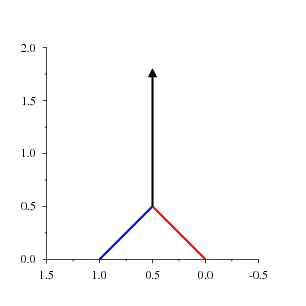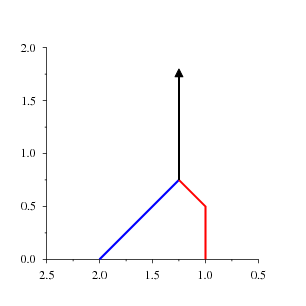This position has been discussed here.
https://www.lifein19x19.com/viewtopic.p ... 65#p260965In a way, it's easy, but in a way, it's not.

-

-

form a unit, like a first line hane-and-connect form a unit, but that fact in this position is not immediately obvious, if you are not used to such positions.
Let's draw the themograph.

The position after

-

is familiar. Let's start with that.
Attachment:
 half point gote 000.png [ 3.51 KiB | Viewed 10214 times ]
half point gote 000.png [ 3.51 KiB | Viewed 10214 times ]
By convention the scores are represented from Black's point of view, and increase as we go to the left. The vertical dimension represents the temperature which is an indicator of how much a play gains. We may think of the horizontal dimension as the value of positions and the vertical dimension as the value of plays.

Black to play can move to a local score of 1 with gote. This move is indicated by the inclined blue wall. White to play can move to a local score of 0 with gote. That is indicated by the inclined red wall. The walls come together at a height (temperature) of ½, which indicates how much each play gains on average. They also come together at a territorial value (count) of ½, which indicates the average value of the position. Since it is not a final score, we call it a count. Above the point where the walls come together the black mast rises vertically. The black mast indicates that neither player will make a local play when larger plays are available elsewhere (as a rule).
Now let's back up to the position after

. This is also a familiar position.
Attachment:
 three quarter point 000.png [ 3.54 KiB | Viewed 10214 times ]
three quarter point 000.png [ 3.54 KiB | Viewed 10214 times ]
The left wall indicates a move to a local score of 2 with gote. The move gains ¾ point. The top part of the right wall indicates a move by White with gote to the position after

. Note the inflection point in the right wall at a count of 1 and a temperature of ½. The right wall of this thermograph indicates the information from the left wall and mast of the thermograph we just drew of the position after

-

. The inflection point indicates that when moves elsewhere gain ½ point or less Black will reply to

, as a rule. That is, in that case White will play

with sente. The black mast rises above temperature ¾ at a count of 1¼.
Finally, the thermograph of the original position.
Attachment:
 half point gote 999.png [ 3.51 KiB | Viewed 10214 times ]
half point gote 999.png [ 3.51 KiB | Viewed 10214 times ]
The left wall of this thermograph is derived from the right wall of the previous thermograph.
This thermograph is exactly like the thermograph of the position after

-

, except for the blue mast between temperature ½ and temperature ¾. Above that the mast is black. The blue mast indicates that when the largest play elsewhere gains between ½ and ¾, Black can play

with sente, as a rule. Black does not need to do so, except perhaps as a ko threat.

Otherwise we may consider the sequence,

-

-

, as a unit.



